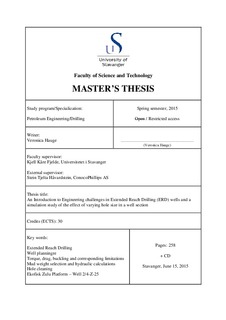| dc.contributor.author | Hauge, Veronica | |
| dc.date.accessioned | 2015-09-21T07:56:32Z | |
| dc.date.available | 2015-09-21T07:56:32Z | |
| dc.date.issued | 2015-06-15 | |
| dc.identifier.uri | http://hdl.handle.net/11250/300804 | |
| dc.description | Master's thesis in Petroleum engineering | nb_NO |
| dc.description.abstract | This thesis investigated Extended Reach Drilling (ERD), an embedded technology for drilling high-inclination, long horizontal directional wells. The objective was to introduce important engineering challenges in ERD wells and study the effect of varying hole size in a well section. A ConocoPhillips standard is to drill a 12 ¼” x 13½“ hole for the 10¾” production liner. Is this the optimum hole size considering torque, drag and buckling, hole cleaning and ECD (equivalent circulating density) management? Will a change in section depth have an impact?
Three important types of engineering studies will be introduced and further explained in this thesis. These studies have to be performed during the planning of ERD wells and will also become critical when studying an ERD well. It is also important to closely follow it up during operation to see if any deviation from trends. The three studies include:
1. Torque, drag, buckling and corresponding limitations
2. Mud weight selection and hydraulic calculations
3. Hole cleaning
There are three main reasons for drilling extended reach wells [9]: surface location constraints, reduced infrastructure costs and increased reservoir contact. ERD makes it possible to reach a larger area from one surface drilling location and to enter reservoirs at locations remote from a drill site, eliminating additional platforms and costly offshore operations [24], [64]. Both the well-site footprints and the environmental effects are reduced through ERD technology in addition to enhanced reservoir drainage at reduced cost [63]. As mentioned above, ERD technology offers the possibility for reservoir production [63]. It is possible to keep a well in a reservoir for a longer distance than earlier to maximize both the productivity and the drainage capability [24], [64].
Ekofisk was the first oil field at the NCS, discovered late in 1969 and it is the focus of this thesis. There are four producing fields in the Greater Ekofisk Area: Ekofisk, Eldfisk, Embla and Tor [27]. Today the Ekofisk field produces oil and gas corresponding to about 200.000 barrels of oil equivalents per day [31]. To maintain production and increase the oil recovery, the use of extended reach wells has become more and more common. However, the geological and design complexities on the Ekofisk field may create difficulties when the wells are somewhat longer than previously drilled.
This thesis has used WellPlan to perform simulations on a specific well section on the Conoco Phillips’ ERD well Z-25 on Ekofisk studying the effect of varying hole size. It involves a sensitivity analysis comparing a total of 12 different hole sizes ranging from 12¼” to 15” with increments. The overall objective for all the simulations is to study the effect of varying hole size in the 12¼” x 13½” hole section (under-ream to 13½” while drilling with a 12¼” bit). The simulations include torque, hook load, side forces, ECD, hole cleaning and pressure loss. It resulted in important observations, relevant for future ERD decisions. Main challenges with ERD also discussed in this thesis are summarized below:
1. Transferring weight on bit (WOB)
2. Buckling
3. Tensile limit on the drillstring during tripping out (POOH)
4. Surface torque limit on drillpipe/couplings
5. Rig capability
6. ECD in annulus for long wells
7. Hole cleaning
8. Pump pressure vs. flowrate requirement | nb_NO |
| dc.language.iso | eng | nb_NO |
| dc.publisher | University of Stavanger, Norway | nb_NO |
| dc.relation.ispartofseries | Masteroppgave/UIS-TN-IPT/2015; | |
| dc.rights | Navngivelse 3.0 Norge | * |
| dc.rights.uri | http://creativecommons.org/licenses/by/3.0/no/ | * |
| dc.subject | petroleumsteknologi | nb_NO |
| dc.subject | petroleum engineering | nb_NO |
| dc.subject | boreteknologi | nb_NO |
| dc.subject | extended reach drilling | nb_NO |
| dc.subject | well planning | nb_NO |
| dc.subject | torque, drag, buckling and corresponding limitations | nb_NO |
| dc.subject | mud weight selection | nb_NO |
| dc.subject | hydraulic calculations | nb_NO |
| dc.subject | hole cleaning | nb_NO |
| dc.title | An introduction to engineering challenges in Extended Reach Drilling (ERD) wells and a simulation study of the effect of varying hole size in a well section | nb_NO |
| dc.type | Master thesis | nb_NO |
| dc.subject.nsi | VDP::Technology: 500::Rock and petroleum disciplines: 510::Petroleum engineering: 512 | nb_NO |

